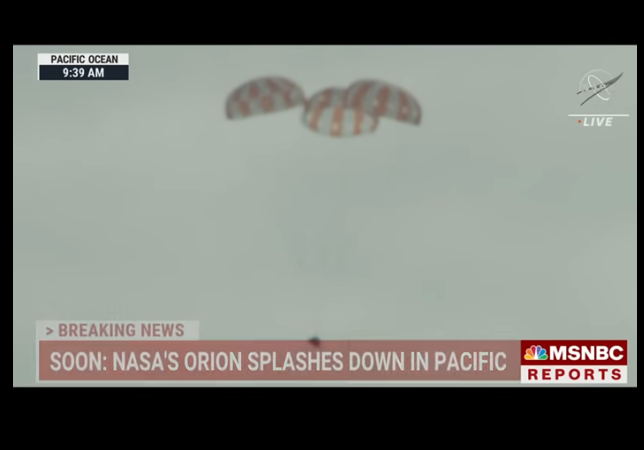NASA’s Orion Capsule Splashes Down in Pacific, Completing Artemis I Mission

NASA’s Artemis I mission to the moon and back finished as its Orion capsule splashed down in the Pacific Ocean on Sunday after making an uncrewed voyage around the moon.
The Artemis I Orion capsule has splashed down after a 25-day trip that reached within 60 miles of the moon, completing the first step in an ambitious plan to establish a long-term presence there and later send a crewed shuttle to Mars.The spacecraft spent 25.5 days in space and journeyed on a 1.4-million-mile journey around the Moon, according to NASA.”Our spacecraft is home,” NASA tweeted at 9:41 a.m. PT Sunday, shortly after the splashdown occurred near Baja California, Mexico.
The Orion successful mission is part of the long-range plan for crews to return to the lunar surface.
The splashdown capped a 25-day mission less than a week after passing about 79 miles (127 km) above the moon in a lunar fly-by, and came about two weeks after reaching its farthest point in space, nearly 270,000 miles (434,500 km) from Earth.Roughly 30 minutes before splashing down, the capsule committed to a fiery, 20-minute plunge into Earth’s atmosphere when it shedded its service module in space, exposing a heatshield that reached peak temperatures of nearly 5,000 degrees Fahrenheit (2,760 degrees Celsius) during its blazing-fast descent.Atmospheric friction slowed the capsule from 24,500 miles per hour (39,400 kph) to 325 mph, followed by two sets of parachutes that helped brake its speed to an expected 20 mph at splashdown. The capsule showed a “perfect” descent rate, Navias said.
The capsule will be heading back to the Kennedy Space Center (KSC) by way of my hometown.
A U.S. Navy ship, the USS Portland, was waiting in the area. The Portland will haul Orion aboard and ferry it to port in San Diego, a journey that will take about a day, NASA officials have said. From there, Orion will travel to KSC for in-depth inspections and analysis.”This is an extraordinary day,” NASA Administrator Bill Nelson told Navias shortly after splashdown. “It’s historic, because we are now going back into space — into deep space — with a new generation.”
Artemis II, which will be a crewed flight around the moon, is currently set to go in May 2024.
There will be four astronauts aboard Artemis II. Three will be from NASA, and one will be Canadian, part of the agreement spelling out the Canadian Space Agency’s participation in the Artemis program. NASA has not yet announced who will fly on the mission.The trajectory of Artemis II will be fairly simple. After launch, the second stage of the Space Launch System will push Orion into an elliptical orbit that loops as far out as 1,800 miles above Earth, giving the astronauts time to see how Orion’s systems work.Then, when Orion speeds around again, its engine will fire to send it toward the moon. For Artemis II, the Orion spacecraft will not enter orbit around the moon; it will instead use the moon’s gravity to sling back to Earth for a Pacific Ocean splashdown. The entire trip should take around 10 days.
Hopefully, the Artemis II won’t experience hurricane delays or need repairs for leaks.
CLICK HERE FOR FULL VERSION OF THIS STORY